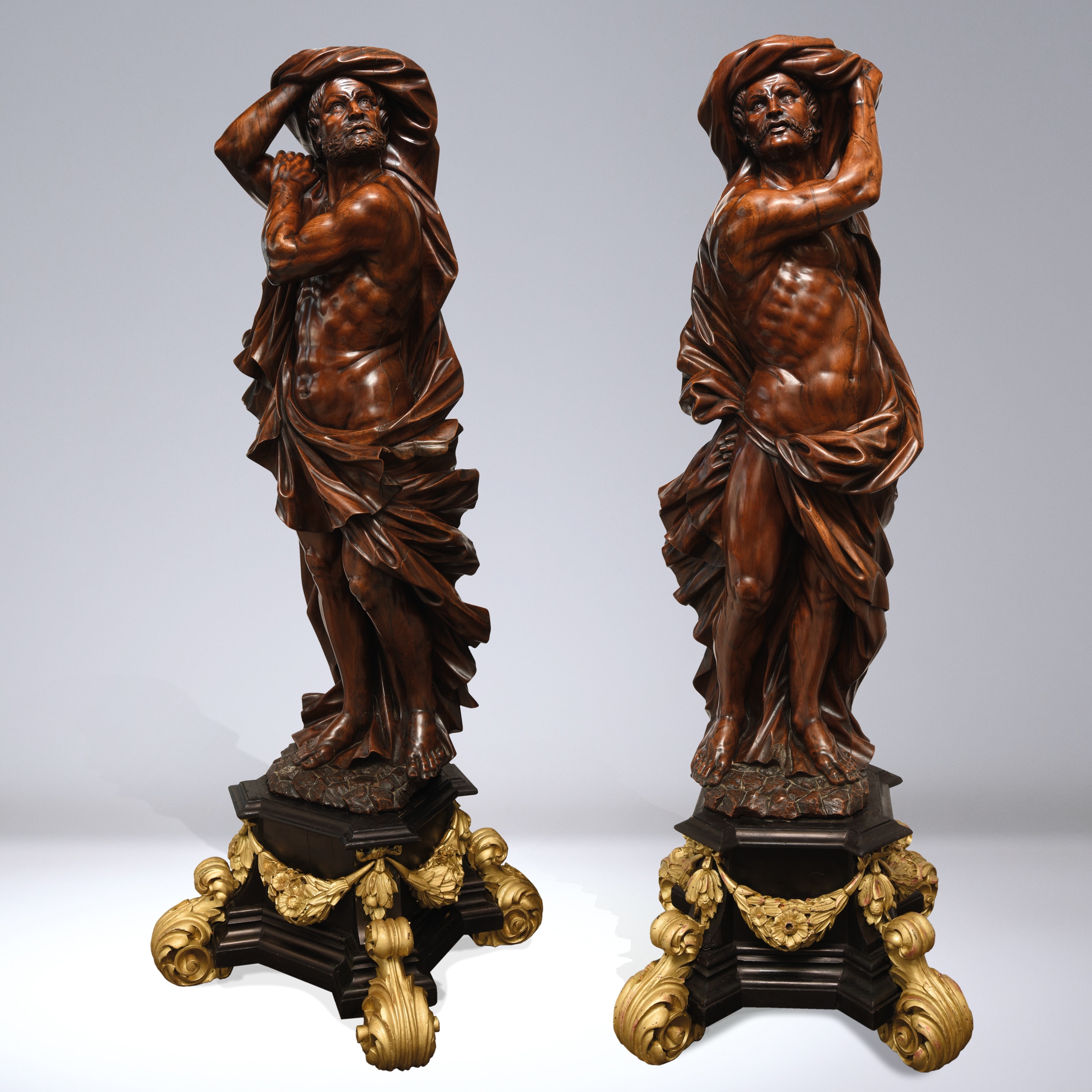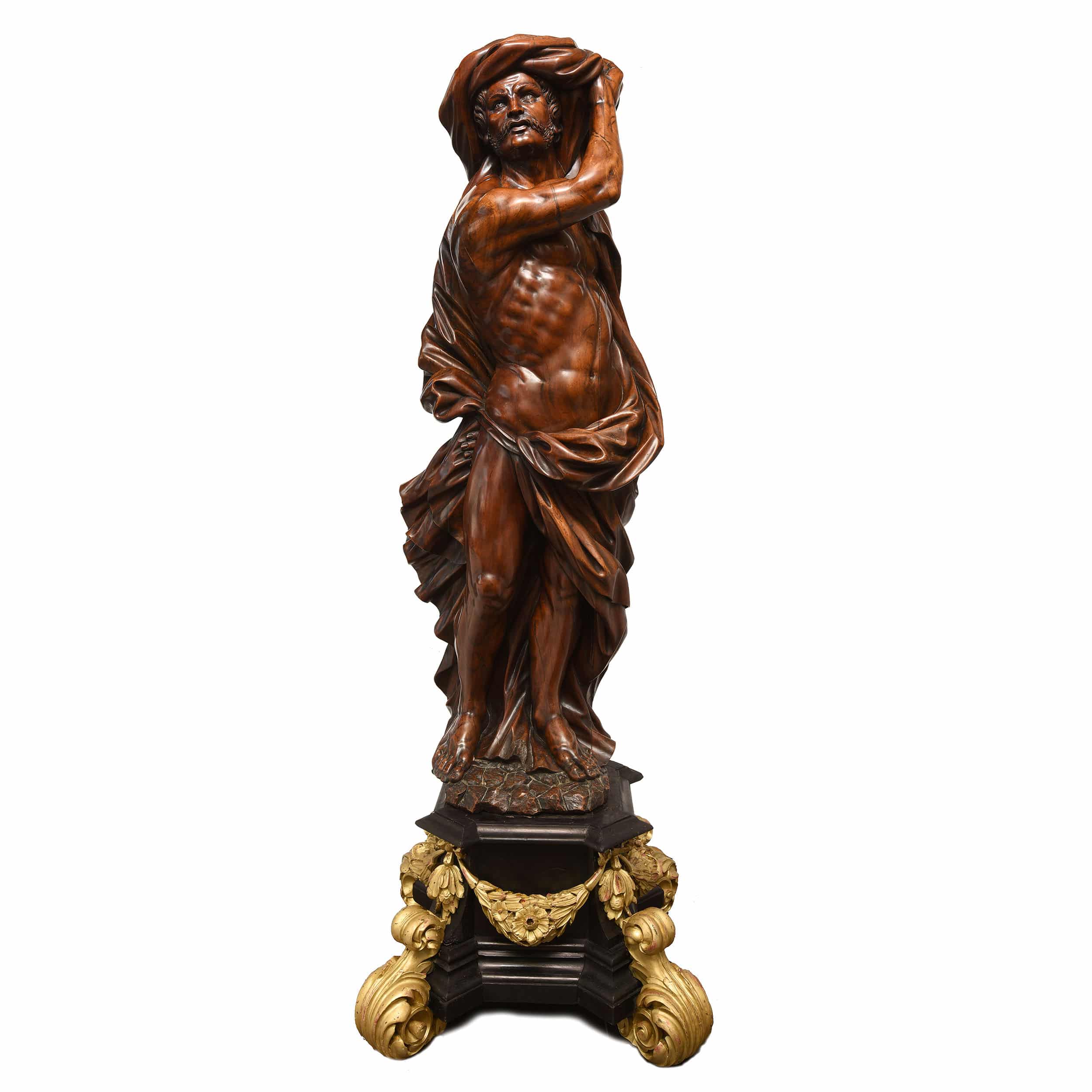GIACOMO PIAZZETTA (1640 -1705), attribué à
Bois (noyer) sculpté, reposant sur des socles en bois noirci sculpté et doré
Hauteur : 160 cm (sans les socles) ;
largeur : 60 cm ; profondeur : 40 cm
Provenance
Collection Privée française
Bibliographie
Nava-Cellini, Antonia, Storia dell’arte in Italia, La scultura
del Seicento, Turin, 1982, pp. 194-197.
Spiazzi, de Grassi, Galasso (a cura di), Andrea Brustolon
1662-1732 ; il Michelangelo del legno, Skira,
Milan, 2009, cat. 8 p. 313.
Ces deux atlantes ou télamons(1) sont attribués à Giacomo
Piazzetta par Alexandre Lacroix.
Sculpteur né au nord de Trévise, Piazzetta est documenté à Venise
à partir de 1666, date à laquelle il entre dans l’atelier de
Pianta, connu pour ses impressionnantes sculptures en bois à la
Scuola di San Rocco.
La position toute en contrapposto, les bras levés mettant en valeur
la musculature rendue dans son plus petit détail mais aussi
le soin apporté aux plis des vêtements n’est pas sans rappeler
deux autres télamons conservés à Venise, au sein de l’église San
Giovanni e Paolo. En effet, on remarque une très forte similitude
entre les sculptures de Venise et nos deux télamons. Le positionnement des pieds, comme celui des bras, ou encore le rendu de la musculature. Ces pièces commandées à l’artiste pour la Scuola
Grande de Santa Maria della Carita ont été transférées en 1807
à San Giovanni e Paolo.
Giacomo Piazzetta s’était fait une spécialité de ce type de sculpture
car plus tôt (entre 1676 et 1683) il avait déjà reçu commande
de télamons pour orner la bibliothèque des frères dominicains.
Malheureusement, un incendie en détruisit la plus grande partie
et seuls quelques témoins subsistent de cette commande à la
National Gallery of Canada d’Ottawa(2).
On notera enfin que notre paire d’atlantes étant sculptée sur
toutes les faces, il n’est pas impossible que ces sculptures aient
été utilisées en architecture d’intérieur (comme soutien d’une
mezzanine de bibliothèque par exemple), mais aussi comme
élément de mobilier autonome (candélabre ou porte-vase).
A quelques années d’écart, Andrea Brustolon (1662-1732) ne
manquera pas de diffuser énormément cette typologie.
(1) Nom donné aux effigies masculines supportant un entablement
architectural.
(2) Il s’agit des bozzetti en terre-cuite dorée (inv. 26567.1 à 4).
A PAIR OF ATLANTS
Giacomo PIAZZETTA (Pederobba, 1640 - Venice, 1705),
attributed to Carved wood Bois (walnut), on pedestals of gilt and
black wood
Height: 160 cm (without pedestals) ;
length: 60 cm ; width: 40 cm
Provenance
French private collection
Comparative bibliography
Nava-Cellini, Antonia, Storia dell’arte in Italia, La scultura del
Seicento, Torino, 1982, pp. 194-197.
Spiazzi, de Grassi, Galasso (a cura di), Andrea Brustolon 1662-
1732 ; il Michelangelo del legno, Skira,
Milano, 2009, cat. 8 p. 313.
Those two atlants or telamons1 were attributed to Giacomo
Piazzetta by Alexandre Lacroix. Born North of Treviso, Piazzetta
is documented in Venice since 1666, the year he enters Pianta’s
workshop, famous for its impressive wood sculptures at the
Scuola di San Rocco.The contrapposto position, arms raised to
enhance the muscles in detail, but also the care for the drapery
pleats reminds us of two other telamons in the church of San
Giovanni e Paolo in Venice. There is effectively a strong similarity
between them and ours, such as the position of the feet or
the treatment of muscles. These sculptures commissioned for
the Scuola Grande di Santa Maria della Carita were transferred
in 1807 to San Giovanni e Paolo.
Giacomo Piazzetta specialised in this kind of sculpture for earlier
(between 1676 and 1683) he had already been commissionned
for telamons for the library of the Dominicans. Unfortunately,
fire destroyed the main part and only a few of them survive
now, in the National Gallery of Canada in Ottawa2.
It is to be noted that our pair of atlants was sculpted on all
sides, it is not impossible that they were intended as interior
decoration (such as sustaining a library mezzanine), but also as
elements of independent furniture (candelabrum or vase stand).
A few years later, Andrea Brustolon (1662-1732) will produce a
fair number of this kind of works.
(1) Name given to the male effigies sustaining an architectural
entablature.
(2) N fact the gilt-terracotta bozzetti (inv. 26567.1 to 4).
Description complète
















